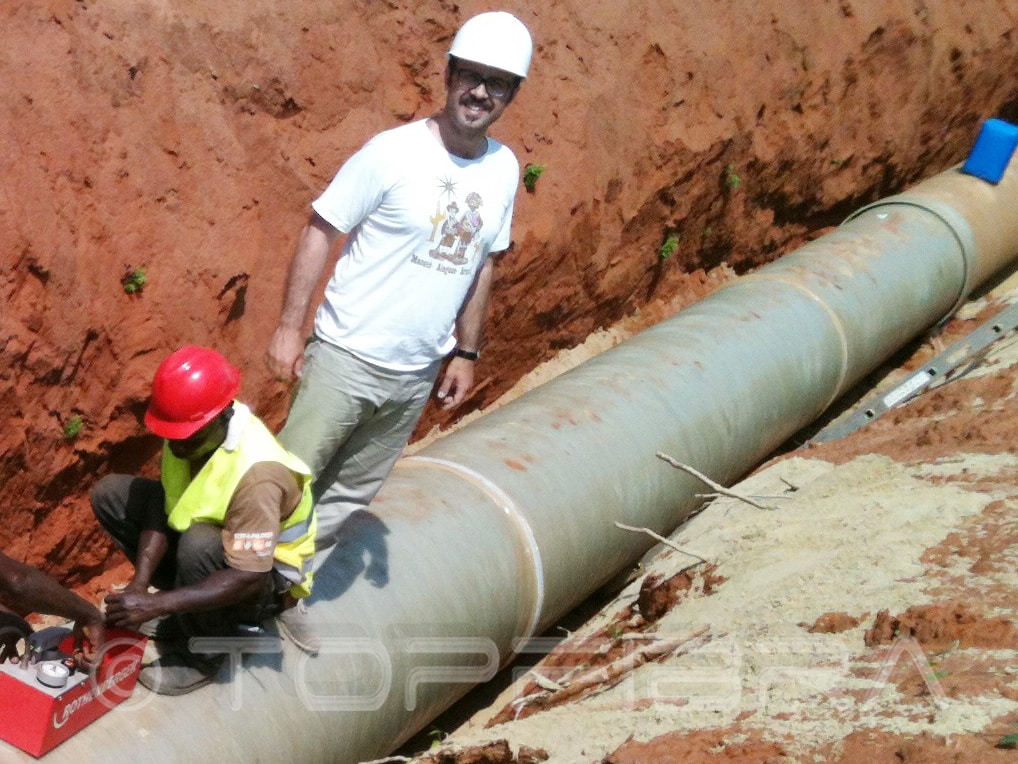I compiled a collection of tips on pipe installation that I believe would be helpful for you. The installation of GRP pipes above and below ground can be tricky. But if you follow these tips, you can have a smoother installation.
Laying GRP pipes above the ground
In the design stage, you define the distance between the supports, the type of supports, the anchorage, and the fixing points. In general, pipes should be supported by concrete cradles surrounding the pipes over an arc of 150° with a layer of rubber in between. This should be at least 4 mm thick.
During the laying operations, it is necessary to take all possible precautions to avoid damaging the product. In particular, you should keep in mind the following steps:
- tightening of the fixed points (clamps) should be carried out with the pipe at the temperature that is expected during the working conditions. The design values should be meticulously respected.
- bolts of flanges should be tightened at the specified loads;
- elbows should be anchored when it is foreseen that the pipe will undergo torsion stresses;
- fittings not made of FRP, such as valves, steel flanges, and the like, should be supported individually;
- battery limits made of different materials, such as connections to equipment or pipelines, should not transfer additional stresses to the FRP pipeline;
- all tee connections should be supported in order to avoid interactive stresses between the mainline and the branch lines.
You have to keep in mind, that these are general tips and do not cover all of the problems associated with the laying of pipes above ground. Therefore, during the design stage, you should analyze the stress for each individual case and select the most suitable support system. When pipes are installed in contact with the flammable products, all metal parts should be earthed to prevent the build-up of electrostatic charges leading to sparks.
Laying GRP pipes below ground
The underground pipes are laid on a bed of sand or screened material, compacted to the level anticipated in the design. Then, you carry out the backfilling process at the sides and above the pipe in layers of 20-30 cm. You use the same material as for the bed.
You should apply the first layer of the backfill with great care since it provides firm support under the pipe. Each layer must be compacted with the methods and systems adapted to the nature of the material employed. Take care to avoid any damage to the pipe during this operation. It is beneficial to increase the vertical diameter of the pipeline during the laying operations by 1% – 3%. This way you compensate for the reduction of the vertical diameter, which occurs during the pipeline operation.
Like with the above-ground installation, it is not possible to provide full instructions for the below-ground laying operations. Each installation has different requirements, but the following recommendations can be very useful.
Recommendations for below-ground pipe installation
- the trench walls should be dug as vertically as possible;
- any contact between the pipe and large stones or rocks should be avoided;
- in the case of the installations below the water table, continuous drainage should be provided in the trench until the backfilling has been carried out;
- crossing areas, subjected to heavy external loads (permanent or mobile), must be very carefully analyzed to establish if special steps have to be taken, e.g. different stiffness to fit the situation, increased burial depth, use of sheet metal or a reinforced concrete cover;
- in soils with a low modulus of reaction, such as clayey soil, or grounds with a high content of organic substances, the width of the trench should be increased and pipes should be surrounded with the compacted and selected backfilling material;
- the behavior of the underground pipes is greatly affected by the surrounding soil. When carrying out the laying operations, it is, therefore, essential to comply with the requirements of the design.
An engineer designing underground pipelines should take great care in examining the soil parameters. In case they have any doubts, they should assume the worst possible conditions.
Do you have any questions or concerns about your pipe installation?
Feel free to contact us by clicking on the button below.

